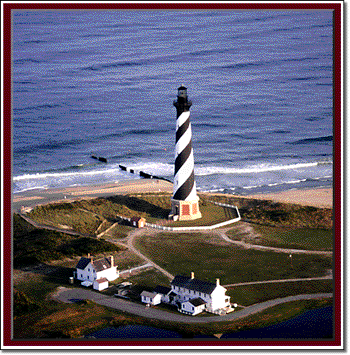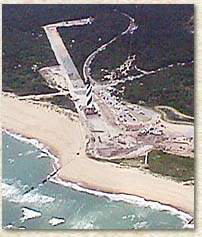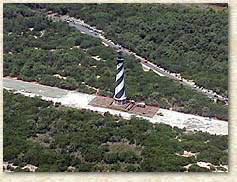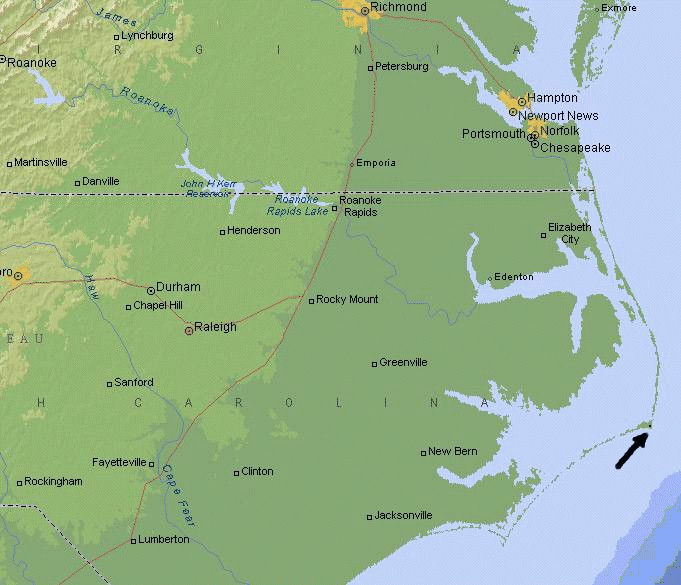TARGET 060621
Moving a lighthouse
|

|
Cape Hatteras Light was 1600 feet (490 meters) from the ocean
when it was completed in 1870. In June 1999 it stood just a
few feet from the open beach, protected by rows of sandbags
but vulnerable to the next passing summer hurricane or winter
nor'easter.
Everyone agreed that if nothing was done the sea would destroy
the lighthouse before our eyes within a very few years. The
National Park Service, which owns most of Hatteras Island as
part of the Cape Hatteras National Seashore, decided to move the
lighthouse and its associated buildings 2900 feet (about 880 meters)
to the southwest. This move, diagonally away from the ocean, places
the lighthouse about as far from the sea as it was in 1870.
There was substantial opposition to the move, much of it coming
from residents of Hatteras Island and of the Outer Banks. Opponents
of the move were afraid the lighthouse was too large and too old to
move; they feared it would crumble en route and be lost. They
believed the lighthouse was historic where it stood, and some of
that historical context would be lost in a new location. And they
believed that the beach in front of the lighthouse could be preserved
by building a new groin (a wall projecting into the ocean, designed
to trap sand moving along the coast) and by installing other
sand-catching devices in the surf.
In 1988, the National Research Council, an arm of the National Academy
of Sciences, released a report, requested by the Park Service, which
considered all the available options and recommended strongly that the
lighthouse be moved.
In 1997, Governor Hunt and other state leaders asked the NC State
engineering and science faculties to review the NAS-NRC report and
update it if needed. The faculty concluded the original report was
correct and the lighthouse should be moved.
There's no doubt lighthouses can be moved. Three have been moved in
recent years in New England: the Cape Cod Highland and Nauset
lighthouses in Massachusetts and the Southeast Block Island lighthouse
in Rhode Island. However, opponents of moving Cape Hatteras Light
were correct in pointing out that North Carolina's lighthouse is a
different animal from these New England structures.
New England lighthouses are typically built on top of cliffs overlooking
the ocean, not on sandy beaches. These lighthouses don't need to be tall,
since they are already up in the air. The three relocated lighthouses are
from 48 to 62 feet tall (14.6-18.9 meters) and weigh around 500 tons (450
metric tons) each. Cape Hatteras is the nation's tallest and (probably)
heaviest lighthouse; it is the tallest brick lighthouse in the world.
At 208 feet tall (63.4 meters) it is four times the height and ten
times the weight of its New England cousins.
The foundation of the building was excavated and a
diamond-studded saw was used to cut through its granite foundation.
As the granite was removed, steel pillars, called shoring towers,
were substituted to support the structure. Hydraulic jacks were used
to lift the building slowly from its old location.
|

Steel rails were inserted under the base of the lighthouse to support
the building during the move.

Special rollers bolted to the rails gave the building its mobility.
|
|
|
The lighthouse was then eased very slowly
towards its new location, pushed by five large hydraulic rams
mounted on the rails behind the base. The rate of motion
was about 25-100 feet or 8-30 meters per day: so slow the lighthouse
did not appear to be moving at all. It took more than a month
for the lighthouse to reach its new home.
|

Progress on June 24th

Progress on July 2nd
|
Because it has a heavy base and tapered shape, the lighthouse is not
at all top heavy. This means it did not have any tendency to tip over.
Although there was a lot of concern about the lighthouse cracking
when it was moved, engineers said the building is so massive in
construction it was actually a very good candidate for being moved
without any damage of this kind. The real problem was to be sure
that the ground underneath was firm enough over the whole route to
permit a smooth passage. For this purpose the soft surface sand was
removed along the route and replaced with a thick bed of gravel.
The two lightkeeper's houses and other associated structures around
the base of the lighthouse were also moved. They weren relocated so
they will have exactly the same relationship to the lighthouse they
have had since they were built. (However, in one important respect
the new location will not be authentic: it is surrounded by dense
shrubbery at the edge of the Buxton Woods maritime forest. Old photos
show that since 1870 the lighthouse has always stood in a relatively
open, sandy site.)
As famous as the lighthouse already was, the move made it much more
famous. It is amazing to think of moving such a structure, but perhaps
not more amazing than to think of building it, on a sandy beach in
one of the most exposed places in the world, in 1870. No doubt the
builders of the lighthouse would be proud to see the level of concern
and talent being concentrated on its preservation.
|
DOWSING FEEDBACK MAP

|







